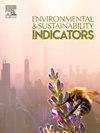A different destiny after the ice age: Impacts of climate change on the global biogeography of Carasobarbus
IF 5.4
Q1 ENVIRONMENTAL SCIENCES
引用次数: 0
Abstract
Climate change poses a significant global challenge, profoundly affecting species distribution. In recent years, research focusing on the impacts of climate change on freshwater taxa has been relatively limited compared to studies on terrestrial taxa. This study seeks to identify hotspots and occurrences of all Carasobarbus freshwater fish species while also predicting the potential implications of climate change through the use of ensemble species distribution modeling (ESDM). Analyze climatic changes across various temporal scales: the Mid-Holocene (6000 years BP), the Last Glacial Maximum (21,000 years BP), the present, and future projections (2061–2080). Global circulation models (GCMs) showed strong predictive capabilities for the species climatic niches, with Area under the curve (AUC) and true skill statistics (TSS) values. Key predictors included Annual Mean Temperature, Mean Temperature of the Driest Quarter, and Precipitation of the Driest Month. The analysis revealed varied responses to climate change: Five and seven species are expected to lose climatically suitable habitats (losers) in SSP 126 and SSP 585, respectively, indicating heightened vulnerability, in SSP126 and SSP 585 four and three species are expected to see an increase (Winners) in their range respectively, and additionally, in SSP 126 and SSP 585 two and one species are anticipated to maintain approximately stable (Under 1 % change) distributions within their ranges under the specified scenarios. Additionally, the Iran-Anatolian hotspot emerges as crucial for Carasobarbus populations globally. The research highlights the effects of climate change on Carasobarbus distribution patterns, providing essential insights for conservation strategies and management to protect biodiversity in vulnerable regions.
冰河期后的不同命运:气候变化对卡拉索巴斯全球生物地理的影响
气候变化是一项重大的全球性挑战,深刻影响着物种的分布。近年来,与陆生类群的研究相比,侧重于气候变化对淡水类群影响的研究相对有限。本研究旨在确定卡拉索巴尔布斯所有淡水鱼类物种的热点地区和出现情况,同时通过使用物种分布集合建模(ESDM)预测气候变化的潜在影响。分析不同时间尺度的气候变化:全新世中期(公元前 6000 年)、末次冰川最盛时期(公元前 21000 年)、现在以及未来预测(2061-2080 年)。全球环流模型(GCMs)对物种的气候龛位具有很强的预测能力,其曲线下面积(AUC)和真实技能统计(TSS)值都很高。主要预测因子包括年平均气温、最干旱季度的平均气温和最干旱月份的降水量。分析结果显示了对气候变化的不同反应:在 SSP 126 和 SSP 585 中,预计将分别有五种和七种物种失去气候适宜的栖息地(输家),这表明其脆弱性增加;在 SSP126 和 SSP 585 中,预计将分别有四种和三种物种的分布范围增加(赢家);此外,在 SSP 126 和 SSP 585 中,预计将分别有两种和一种物种在特定情景下在其分布范围内保持大致稳定(变化低于 1%)。此外,伊朗-安纳托利亚热点地区对 Carasobarbus 的全球种群至关重要。这项研究强调了气候变化对疣鼻天鹅分布模式的影响,为保护脆弱地区生物多样性的保护战略和管理提供了重要启示。
本文章由计算机程序翻译,如有差异,请以英文原文为准。
求助全文
约1分钟内获得全文
求助全文
来源期刊

Environmental and Sustainability Indicators
Environmental Science-Environmental Science (miscellaneous)
CiteScore
7.80
自引率
2.30%
发文量
49
审稿时长
57 days
 求助内容:
求助内容: 应助结果提醒方式:
应助结果提醒方式:


